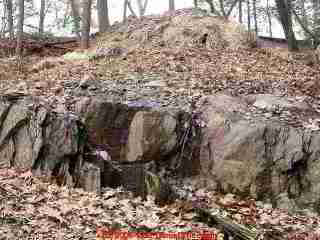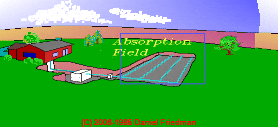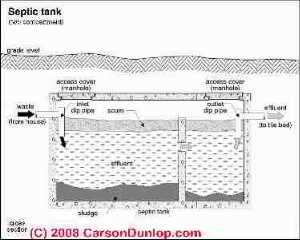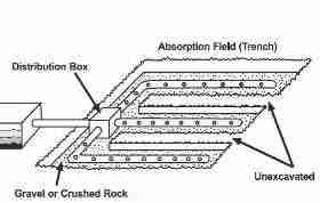 The Basics of Onsite Septic Wastewater Treatment
The Basics of Onsite Septic Wastewater Treatment
- POST a QUESTION or COMMENT about residential onsite wastewater or septage or sewage treatment
Wastewater treatment:
This article series explains the basics of onsite wastewater treatment processes - what is an onsite or private septic system & how does it work?
Wastewater treatment is "The process of removing pollutants and pathogens from wastewater, discharging the water to the environment where it is recycled, and disposing of the byproducts of the treatment process."
InspectAPedia tolerates no conflicts of interest. We have no relationship with advertisers, products, or services discussed at this website.
- Daniel Friedman, Publisher/Editor/Author - See WHO ARE WE?
The Basics of Onsite Wastewater Treatment
 Onsite Wastewater Treatment Systems - Burks & Minnis
Onsite Wastewater Treatment Systems - Burks & Minnis
Our photograph at page top shows a private septic system which demonstrated failure even before we began our septic loading and dye test. A too-small septic tank installed at the top of a steep hill emptied into a too-small gravel pit buried in less than 36" of soil which in turn sat upon solid rock at the top of this steep site.
Effluent could be seen running down the face of nearby rocks
whenever the septic system was in use. In the upper portion of the photo (above at page top) you can see a overflow pipe protruding from the septic tank itself, and also hay which the owner or contractor had piled atop of this system in anticipation that we would not notice its unfortunate condition.
Of course by simply taking a few steps down the hillside and looking up, these regrettable conditions were quite visible. Effluent simply ran down the hillside and into a nearby stream.
The Basics of Wastewater Treatment in a Private Septic System
"Treatment" of wastewater (sewage that flows out of building toilets, sinks, showers) means making sure that the wastewater released to the environment is acceptably clean.
In a most-conventional private home septic system, this is about what happens:
Step1: Waste flows from House Toilets & Other Fixtures to Septic Tank
Wastewater flows from building toilets (and sinks, showers, etc.) through building drains, usually by gravity, out to a septic tank, buried in the ground, often close (10 ft.) to the house.
That wastewater will include waste from a flushed toilet, containing excrement and urine, and in many buildings, also wastewater from showers, tubs, and sinks.
Step 2: What Happens in the septic tank: Treatment + solids retention
The job of the septic tank is to retain solid waste, oils, and grease in the tank, and to perform limited (perhaps 45%) treatment of the sewage by bacterial and other microbial action which digest organic waste and pathogens.
So baffles in the septic tank keep floating scum, solids, greases and oils from flowing out of the septic tank and into the drainfield or soakaway bed. Other solid waste material settles to and collects on the bottom of the septic tank as sludge.
Periodically the solid sludge from the tank bottom and floating scum from the tank top must be removed by a septic pumping contractor.
If the septic tank baffles are removed or omitted, or if the solids and scum in the septic tank become too thick, one or two bad things happen:
the septic tank may accepting wastewater - causing toilets to overflow or sewage to back up into the building
or
solid waste may be forced out of the septic tank, flowing into the drainfield, clogging and destroying that component and also ultimately leading either to sewage backup in the building or sewage flowing to the ground surface.
Any of those conditions lead to both health hazards and significant repair costs.
Step 3: Septic Tank Effluent Flows out of the Septic Tank & Into the Drainfield
Liquid from the septic tank (clarified effluent) flows out of the septic tank and into the drainfield - a network of perforated pipes buried in the ground, often in gravel-filled trenches, perhaps 12" to 24" below ground level.
Depending on where you live a "drainfield" might be called a leachfield, soakaway bed, seepage bed.
In the drainfield, also called leach field, seepage bed, or soil absorption
system, the effluent seeps out of perforations in the pipes, through gravel in the trench, and into
the soils below the trench system.
In the drainfield, small suspended solids
(tiny bits of floating sewage debris) which flowed out of the septic tank n the effluent, are filtered by the soils of the drainfield and captured there.
Step 4: Septic Drainfield to Nature
Around the drainfield trenches a biomat of bacteria and other microorganisms grows naturally in the soil below and around the drainfield.
These microorganisms further digest or break down both the captured suspended solids filtered by the soil, and other pathogens and organics and nitrites and nitrates which are present in the septic effluent.
As effluent passes through and is processed by this biomat, it is eventually released to local soils where it joins ground water already present in the area (disposal).
For difficult home sites where there is limited space, rocky ground, or wet soils, a variety of "advanced" wastewater treatment systems are available to successfully handle the process I've just described.
At our Continue Reading lilnk below we expand and add detail to the "how a septic tank works" just described, above, beginning with explaining the terms that septic designers, engineers, and other experts use to describe typical as well as alternative methods of treatment of wastewater.
All of these septic systems have the same objective: when septic effluent is finally released to the environment it must be as clean or cleaner than the natural groundwater which is already there, and must be clean enough so as not to be a health hazard or harmful to the environment.
...
Continue reading at FIVE WASTEWATER TREATMENT TASKS or select a topic from the closely-related articles below, or see the complete ARTICLE INDEX.
Or see these
Recommended Articles
- DRAINFIELD TREATMENT EFFECTIVENESS
- FIVE WASTEWATER TREATMENT TASKS
- FIVE WASTESATER TREATMENT PROCESSES
- PERCENTAGES of WASTEWATER TREATMENT ACHIEVED
- SEPTIC BACTERIA CONTAMINATION LEVEL
- SEPTIC SYSTEM BASICS
- SEPTIC INSPECTION & TEST GUIDE
Suggested citation for this web page
WASTEWATER TREATMENT BASICS at InspectApedia.com - online encyclopedia of building & environmental inspection, testing, diagnosis, repair, & problem prevention advice.
Or see this
INDEX to RELATED ARTICLES: ARTICLE INDEX to SEPTIC SYSTEMS
Or use the SEARCH BOX found below to Ask a Question or Search InspectApedia
Ask a Question or Search InspectApedia
Questions & answers or comments about residential onsite wastewater or septage or sewage treatment
Try the search box just below, or if you prefer, post a question or comment in the Comments box below and we will respond promptly.
Search the InspectApedia website
Note: appearance of your Comment below may be delayed: if your comment contains an image, photograph, web link, or text that looks to the software as if it might be a web link, your posting will appear after it has been approved by a moderator. Apologies for the delay.
Only one image can be added per comment but you can post as many comments, and therefore images, as you like.
You will not receive a notification when a response to your question has been posted.
Please bookmark this page to make it easy for you to check back for our response.
IF above you see "Comment Form is loading comments..." then COMMENT BOX - countable.ca / bawkbox.com IS NOT WORKING.
In any case you are welcome to send an email directly to us at InspectApedia.com at editor@inspectApedia.com
We'll reply to you directly. Please help us help you by noting, in your email, the URL of the InspectApedia page where you wanted to comment.
Citations & References
In addition to any citations in the article above, a full list is available on request.
- In addition to citations & references found in this article, see the research citations given at the end of the related articles found at our suggested
CONTINUE READING or RECOMMENDED ARTICLES. - Our recommended books about building & mechanical systems design, inspection, problem diagnosis, and repair, and about indoor environment and IAQ testing, diagnosis, and cleanup are at the InspectAPedia Bookstore. Also see our Book Reviews - InspectAPedia.
- In addition to citations & references found in this article, see the research citations given at the end of the related articles found at our suggested
CONTINUE READING or RECOMMENDED ARTICLES.
New York State Department of Health, APPENDIX 75-A WASTEWATER TREATMENT STANDARDS - INDIVIDUAL HOUSEHOLD SYSTEMS , [PDF] New York State Department of Health, 3 February 2010, retrieved 3/1/2010, original source: https://www.health.ny.gov/regulations/nycrr/title_10/part_75/appendix_75-a.htm
Mark Cramer Inspection Services Mark Cramer, Tampa Florida, Mr. Cramer is a past president of ASHI, the American Society of Home Inspectors and is a Florida home inspector and home inspection educator. Mr. Cramer serves on the ASHI Home Inspection Standards. Contact Mark Cramer at: 727-595-4211 mark@BestTampaInspector.com
John Cranor [Website: /www.house-whisperer.com ] is an ASHI member and a home inspector (The House Whisperer) is located in Glen Allen, VA 23060. He is also a contributor to InspectApedia.com in several technical areas such as plumbing and appliances (dryer vents). Contact Mr. Cranor at 804-873-8534 or by Email: johncranor@verizon.net
Advanced Onsite Wastewater Systems Technologies, Anish R. Jantrania, Mark A. Gross, Taylor & Francis 2006. Wastewater treatment levels are given for various system designs including conventional septic systems [this text p. 9]
Onsite Wastewater Treatment Systems, Bennette D. Burks, Mary Margaret Minnis, Hogarth House 1994.
"International Private Sewage Disposal Code," 1995, BOCA-708-799-2300, ICBO-310-699-0541, SBCCI 205-591-1853, available from those code associations.
"Manual of Policy, Procedures, and Guidelines for Onsite Sewage Systems," Ontario Reg. 374/81, Part VII of the Environmental Protection Act (Canada), ISBN 0-7743-7303-2, Ministry of the Environment,135 St. Clair Ave. West, Toronto Ontario M4V 1P5 Canada $24. CDN.
Manual of Septic Tank Practice, US Public Health Service's 1959
Septic Tank/Soil-Absorption Systems: How to Operate & Maintain [ copy on file as /septic/Septic_Operation_USDA.pdf ] - , Equipment Tips, U.S. Department of Agriculture, 8271 1302, 7100 Engineering, 2300 Recreation, September 1982, web search 08/28/2010, original source: http://www.fs.fed.us/t-d/pubs/pdfimage/82711302.pdf.
Pennsylvania State Fact Sheets relating to domestic wastewater treatment systems include:
Pennsylvania State Wastewater Treatment Fact Sheet SW-161, Septic System Failure: Diagnosis and Treatment
Pennsylvania State Wastewater Treatment Fact Sheet SW-162, The Soil Media and the Percolation Test
Pennsylvania State Wastewater Treatment Fact Sheet SW-l64, Mound Systems for Wastewater Treatment
Pennsylvania State Wastewater Treatment Fact Sheet SW-165, Septic Tank-Soil Absorption Systems
Document Sources used for this web page include but are not limited to: Agricultural Fact Sheet #SW-161 "Septic Tank Pumping," by Paul D. Robillard and Kelli S. Martin. Penn State College of Agriculture - Cooperative Extension, edited and annotated by Dan Friedman (Thanks: to Bob Mackey for proofreading the original source material.)
Advanced Onsite Wastewater Systems Technologies, Anish R. Jantrania, Mark A. Gross. Anish Jantrania, Ph.D., P.E., M.B.A., is a Consulting Engineer, in Mechanicsville VA, 804-550-0389 (2006), Advanced Onsite Wastewater Systems Technologies. Outstanding technical reference especially on alternative septic system design alternatives. Written for designers and engineers, this book is not at all easy going for homeowners but is a text we recommend for professionals--DF. I>
Builder's Guide to Wells and Septic Systems, Woodson, R. Dodge: $ 24.95; MCGRAW HILL B; TP; Quoting from Amazon's description: For the homebuilder, one mistake in estimating or installing wells and septic systems can cost thousands of dollars. This comprehensive guide filled with case studies can prevent that. Master plumber R. Dodge Woodson packs this reader-friendly guide with guidance and information, including details on new techniques and materials that can economize and expedite jobs and advice on how to avoid mistakes in both estimating and construction. Chapters cover virtually every aspect of wells and septic systems, including on-site evaluations; site limitations; bidding; soil studies, septic designs, and code-related issues; drilled and dug wells, gravel and pipe, chamber-type, and gravity septic systems; pump stations; common problems with well installation; and remedies for poor septic situations. Woodson also discusses ways to increase profits by avoiding cost overruns.
Country Plumbing: Living with a Septic System, Hartigan, Gerry: $ 9.95; ALAN C HOOD & TP; Quoting an Amazon reviewer's comment, with which we agree--DF: This book is informative as far as it goes and might be most useful for someone with an older system. But it was written in the early 1980s. A lot has changed since then. In particular, the book doesn't cover any of the newer systems that are used more and more nowadays in some parts of the country -- sand mounds, aeration systems, lagoons, etc.
- Carson, Dunlop & Associates Ltd., 120 Carlton Street Suite 407, Toronto ON M5A 4K2. Tel: (416) 964-9415 1-800-268-7070 Email: info@carsondunlop.com. Alan Carson is a past president of ASHI, the American Society of Home Inspectors.
Thanks to Alan Carson and Bob Dunlop, for permission for InspectAPedia to use text excerpts from The HOME REFERENCE BOOK - the Encyclopedia of Homes and to use illustrations from The ILLUSTRATED HOME .
Carson Dunlop Associates provides extensive home inspection education and report writing material. In gratitude we provide links to tsome Carson Dunlop Associates products and services.



